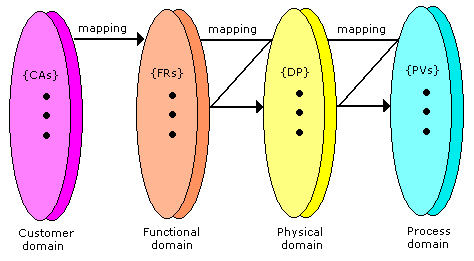Introduction to Axiomatic Design Concepts Used by individuals as well as Fortune 100 development teams, axiomatic design processes bring value to development organizations in diverse industries including software, business processes, automotive, aerospace, semiconductor, medical, government and consumer products. Axiomatic design technology reduces product development risk, reduces cost and speeds time to market by: Formalizing the… Continue reading Introduction to Axiomatic Design Concepts
Category: Articles
Applying Axiomatic Design Concepts to Software Development
Applying Axiomatic Design Concepts to Software Development Axiomatic Design applies equally well to software. In particular it develops a key principle of independence: The goal of system design is to reduce the dependencies between subsystems, especially avoiding circular dependencies. Let’s look at the earlier familiar example that illustrates this issue, which applies equally well to… Continue reading Applying Axiomatic Design Concepts to Software Development
Assess Design Alternatives with Axiomatic Design
Assess Design Alternatives with Axiomatic Design By Al Hamilton Even with strong programs, processes and control initiatives, some products still are more robust and better performers than others. With the operational side of their businesses under good process control, companies now find that quality and robustness must be designed into the product. No amount of… Continue reading Assess Design Alternatives with Axiomatic Design
How Circular Dependencies Impact Design and Development
How Circular Dependencies Impact Design and Development A circular relationship (where Component A affects B, which affects A again) creates coupling between design features. These are called circular dependencies. This is a substandard product solution that consumes development time. A simple example: consider a rearview mirror bracket on a car. The design requirement is to… Continue reading How Circular Dependencies Impact Design and Development
Using DFSS Tools with Axiomatic Design
Using DFSS Tools with Axiomatic Design Integration with Complementary Techniques There are a number of techniques used today in design such as QFD, TRIZ and robust design. The use of these techniques and others is completely consistent with axiomatic design. In fact, axiomatic design can help the designer apply these techniques better. This figure shows… Continue reading Using DFSS Tools with Axiomatic Design
Using Acclaro DFSS™ to Solve Design Problems
Using Acclaro DFSS™ to Solve Design Problems How should companies capture and analyze requirements? Most companies have a marketing document that is reputed to be the requirements document. Design teams need to document and manage their own functional requirements document that represents the current design response to ALL of the potential customers of the design… Continue reading Using Acclaro DFSS™ to Solve Design Problems
Risk Mitigation using Axiomatic Design Functional Requirements Analysis
Risk Mitigation using Axiomatic Design Functional Requirements Analysis Common Root Causes of Project Failure Internet search will consistently identify the following issues: Lack of User Involvement Poor or undocumented requirements Long or Unrealistic Time Scales Scope Creep or lack of requirement change control systems Inadequately trained and/or inexperienced project managers Failure to set and manage… Continue reading Risk Mitigation using Axiomatic Design Functional Requirements Analysis
Solving Software and Business Problems with Axiomatic Design
Solving Software and Business Problems with Axiomatic Design Software iterations are costlier than doing the job right in the first place. If new programming staff has to first learn the code to implement a change, then a software function that would have taken a couple minutes to implement in the original development might take days… Continue reading Solving Software and Business Problems with Axiomatic Design
Solving Product Development Problems with Axiomatic Design
Solving Product Development Problems with Axiomatic Design The following functions of the Axiomatic Design process frequently do NOT occur in traditional product development processes, but reduce iteration risk: Differentiate the design process from the solution space Designers generally jump to a solution, and complete the design within the limiting framework of their initial solution space.… Continue reading Solving Product Development Problems with Axiomatic Design
Axiomatic Design Benefits for Designers
Axiomatic Design Benefits for Designers Benefits to Designers Axiomatic design helps designers with both new and existing designs. In both cases, designers work more creatively and develop better designs in less time. Understand clearly defined problem before designing Identify innovative ways to fulfill functional requirements Avoid frustrating dead ends Reduce random searches for solutions Minimize… Continue reading Axiomatic Design Benefits for Designers





